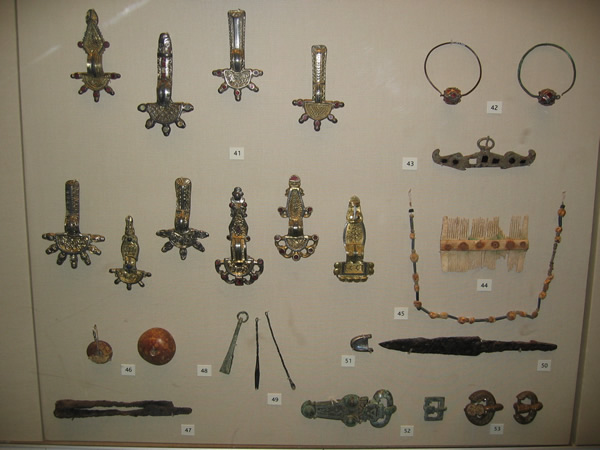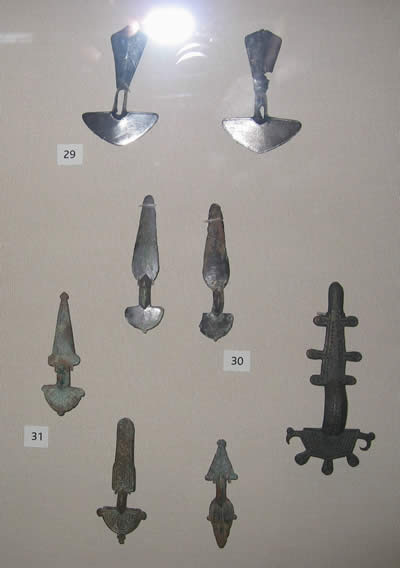Home > English version of HP > History of Saintonge, Aunis and Angoumois > Archaeology > Herpes - Courbillac (16) - An update on the whereabouts of the Herpes (...)
 Herpes - Courbillac (16) - An update on the whereabouts of the Herpes finds
Herpes - Courbillac (16) - An update on the whereabouts of the Herpes finds
Dispersal of the Delamain collection
Saturday 5 April 2008, by , 3444 visites.
All the versions of this article: [English] [français]
DISPERSAL OF THE DELAMAIN COLLECTION
AND FINDS FROM THE 6TH CENTURY FRANKISH CEMETERY OF HERPES (CHARENTE)
See : Herpes - Courbillac (16) – a 6th century Frankish cemetery
This is a note about what is known of the whereabouts today of the Delamain collection of his finds at Herpes. My grateful thanks to Mr. Barry Ager, Curator at the British Museum, London, (Continental Early Medieval Collection, Department of Prehistory & Europe), who has kindly given the information this note is based on.
Recently, the history of some of the objects from the Delamain Collection has been, to some extent, traced and their actual whereabouts established. Research continues on all aspects of the Delamain Collection including its later history. Questions have arisen about whether some of the objects it contained came from Herpes, and there are other objects probably from Herpes that were not part of the published collection.
OBJECTS FROM THE DELAMAIN COLLECTION DISPOSED OF BEFORE THE 1905 AUCTION IN ANGOULÊME
What is known about the pre-World War II history of the collection owes much to the important research by Catherine Haith, (C. Haith, 1988, "Un nouveau regard sur le cimetière d’Herpes (Charente)", Revue Archéologique de Picardie, no. 3/4 - 1988, p. 71-80).
In 1901 the Delamain collection was acquired for Edouard Guilhou by the Parisian dealer, M. Houzeau. But Guilhou was mostly interested in the finger-rings, so he kept these back from sale at the Angoulême auction in 1905. In November 1937, Guilhou’s collection of rings, including pieces from Herpes, was sold at auction in London. The British Museum acquired five of the rings, including one from Mulsanne, but none of them is from Herpes.
However, Guilhou did not only keep back the rings from the 1905 auction. He also withdrew some of the better pieces, and it seems likely that he had sold them privately to the German collector, Johannes von Diergardt.
Von Diergardt kept some of the objects in his own collection until his death in 1934. This collection then passed to the Wallraf-Richartz Museum, Cologne.
Von Diergardt gave other pieces to the Museum für Vor- und Frühgeschichte, Berlin. For a long time it was feared that these objects had been destroyed in 1945 at the end of World War II. However it has recently been revealed that they had, in fact, been seized by the Russian army and taken back to Russia. They are now in museums in St. Petersburg and Moscow (see the excellent catalogue in Russian, German and English of the recent exhibition in St. Petersburg and Moscow, 2007, Merowingerzeit - Europa ohne Grenzen, published by Staatliche Museen zu Berlin. On p. 202 there is a brief discussion of the significance of the cemetery; the material from Herpes, and what is possibly from Herpes, appears mainly on p. 457-467).
The Metropolitan Museum, New York, J. Pierpont Morgan Collection has a number of objects said to be from northern France. However, Catherine Haith, has indicated the possibility that some of them could be from Herpes (see article by Haith 1988, above).
OBJECTS FROM THE DELAMAIN COLLECTION DISPOSED OF AT THE 1905 AUCTION IN ANGOULÊME
British Museum records show that their agents at this auction were the firm of Rollin & Feuardent, which had premises in both London and Paris. The Museum’s register notes that all 1161 of the objects from the Delamain Collection acquired in 1905 are from Herpes.
However, Mr Ager’s own research has shown that this statement must be regarded with great caution. Some of the pieces come from sets of fittings identical to other objects in the Museum’s care, and these other objects are probably from Amiens and other, unknown, sites in northern France, (B.M. Ager, 1997, "Recent re-discoveries in the Continental Early Medieval Collections of the British Museum", in G. De Boe & F. Verhaeghe, eds., Method and Theory in Historical Archaeology. Papers of the ’Medieval Europe Brugge 1997’ Conference, vol. 10, Zellik, p. 139-144). Also, labels on a couple of the pots say that they are from Biron.
All that can be said, therefore, with any degree of certainty about the objects in the British Museum, is that only those that match objects published by Delamain himself come from Herpes. As only about 280 of the 1161 pieces do match Delamain’s published record, the provenance of the rest is uncertain. Unfortunately there is no trace of the Herpes coins in the Museum’s collection.
Today the Delamain collection is a very important part of the Merovingian display in the Museum’s Early Medieval Gallery. There are 66 items of jewellery, belt-fittings, pottery, glass, etc. from the collection, 32 of which were published by Delamain. Here are some images of Herpes, or possibly Herpes, material currently on display in the Museum.

- A selection of Frankish objects
- (Courtesy of the British Museum)

- Most of the Eastern Germanic or Visigothic brooches in the Delamain Collection - the pair of silver brooches (top) are from a different collection from the Marne region
- (Courtesy of the British Museum)

- (Courtesy of the British Museum)

- Two Visigothic buckles in the Delamain Collection but no publication by Delamain concerning these objects has been found, so the actual findsite is uncertain
- (Courtesy of the British Museum)

- Visigothic belt plate from Herpes, according to Haith, 1988
- (Courtesy of the British Museum)
For the time being there is one piece from Herpes in the British Museum available to view online.
See here a reference to Herpes
Images of related exhibits in the Museum can be accessed from these pages. The British Museum is planning to put its database online towards the end of 2008.
 Histoire Passion - Saintonge Aunis Angoumois
Histoire Passion - Saintonge Aunis Angoumois